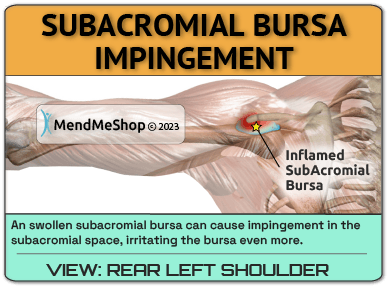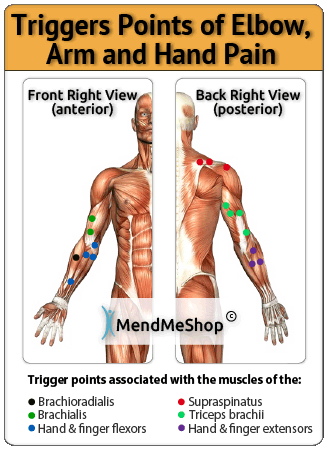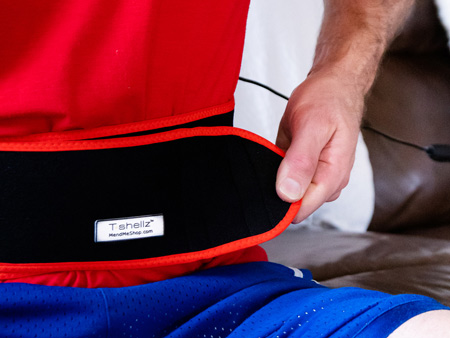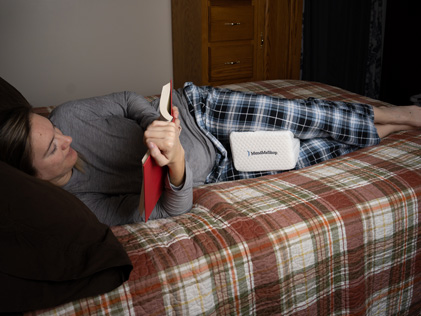Do I Need Bursitis Surgery?
A Bursectomy is a Last Resort
Not every bursitis case will require surgery.

It's generally understood by doctors and surgeons that surgery will introduce more scar tissue into your joint. This added scar tissue will be problematic, requiring visits to your physical therapist (PT) and often significant treatment post-surgery. If not dealt with properly, you could end up in worse condition than before the surgery! This is why surgery is only performed as a last resort - basically for chronic (long term) conditions, septic (infected) bursae and/or severe, continually recurring bursitis pain.
Surgery on soft tissue is generally not considered until all conservative treatment options have been exhausted... or there is an infection, or a large/full tear in one or more of your connective tissues. Most people suffering from bursitis will improve within a couple weeks to a month or two once starting a conservative treatment plan (reference:[1]). However, if the cause is not identified (such as overuse) bursitis can last years.(reference [2]) This is why most doctors, physicians and orthopaedic specialists will recommend that you try at least 3 to 6 or more months of conservative treatments with no sign of improvement before surgery will even be considered.
If You Haven't Done So Yet, Get a Proper Diagnosis

Some serious cases of bursitis may be considered as Surgically Necessary (SN) and will require surgery.In cases of septic bursitis, which is very serious, you will most likely require antibiotic medications and very possibly - surgery. This is why it is important to get to a physician and find out what is really going on - this is known as getting a proper diagnosis. Getting a proper diagnosis would also determine if your pain is a side effect from another condition or disease (Lyme disease is one example). This is less common but nonetheless, very serious. So yes, it is important to get a proper diagnosis.
Understand The Risks That Come From Having Surgery as well as Not Having Surgery
It is always highly recommended that anyone considering surgery always have a clear understanding of the risks as well as the benefits of elective surgery. In addition, one should be aware of the success rate of the particular surgery in question, combined with the post-surgical recommendations that will typically have an impact on your chances of success. I should say here that overall, the statistics for foot surgery are not great, which is one of the major reasons you may find a surgeon reticent to operate on your injured foot unless they are fully convinced it is necessary. Your surgeon should provide a treatment plan to help you regain use of the affected area as soon as possible.
As with any surgery there are risks to every procedure depending on a lot of factors, including your age, the severity of your injury and your level of health going into the procedure. It's always best to discuss all possible risks and complications with your doctor before the procedure. It's important to be aware of the risks you may face with any procedure intended to fix or relieve pain from your foot injury.
Full Ruptures (termed "avulsion") Can Worsen Quickly
One week after your muscle has ruptured, it will begin to travel away from the bone and/or separate from the remaining muscle. The ends of the tear begin to fill in with scar tissue as part of the healing process. This added scar tissue decreases the natural strength of connective tissue and will have a negative effect on your ability to do normal activities. Although not as quickly, more fibrous tissue such as tendons and ligaments will also shrink and weaken after a rupture.
Atrophy (wasting away of tissue) will start only after a few days of disuse. As time passes, connective tissue fibers shrink and weaken. If scar tissue is present then a more complicated procedure may be needed to clean out the presence of any scar tissue for optimal healing after the surgery. The tissue that has ruptured may need to be retrieved from inside your other tissue back to the original attachment point. Your surgeon may make a larger incision into your skin so they're able to retrieve this tissue.
An injury that is 4 to 6 weeks old is considered a chronic rupture. When you have a chronic tissue rupture, the tear continues to separate further over time, increasing the gap. A chronic rupture requires a difficult, drastic surgery - often times there may be a transfer of tissue ("grafting") needed to complete the surgery and a lengthy recovery period.
If Surgery Is Not Necessary....

If you are not at the surgery stage and your physician has opted to treat your injury with conservative treatment options, then you will find that many of our customers have had great success treating themselves with the powerful conservative treatment products such as the Plantar TShellz Wrap®. When used as directed, it is our opinion that the TShellz Wrap® when combined with an overall conservative treatment plan, will give you the best chances of healing your plantar fasciitis or related soft tissue injury at home without the need for surgery. If surgical intervention is required, you will be put on a post-surgery recovery plan by your surgeon or physician. We feel the TShellz Wrap® also plays a valuable role in post surgery recovery, but do not use them for at least 6 weeks after surgery, and only on approval from your physician or surgeon. (Basically do not use heat based treatments until the wound has healed, swelling has dropped and you have recovered enough to have been assigned a home stretching plan). The TShellz Wraps®, when used at this time should be quite effective at enhancing range of motion and minimizing scar tissue growth (which is a major problem when talking about foot surgery).
For acute (new or recent) plantar, or sesamoiditis injuries that have the ability to heal on their own - your doctor may even suggest use of a removable foot brace. A removable foot brace can be very helpful to prepare you for physical therapy sessions and mobility exercises.
However, prolonged use of a removable foot brace or long-term rest (restricted movement) without proper exercise or stretching can make your plantar condition worse. If your foot remains completely immobilized and at constant rest, the edges of your soft tissue tear will begin to fill in with scar tissue as part of the healing process. You may also have on-going symptoms of pain, swelling, inflammation, and even poor blood flow circulation.
Home Conservative Treatments For Bursitis That Many of Our Clients Have Found to be Effective:
- Rest - This is important for initial healing; rest and elevation will help reduce pain, swelling and inflammation in the early stages of injury. This can be difficult when you have to carry on with daily activities, but resting and elevating the injury whenever you can is recommended. During your recovery modify or avoid the activities that caused your bursitis (and often tendinitis as well) until your pain and inflammation settles. However, too much rest can also be harmful to such injuries because joint immobility can actually cause stiffening. This is why rest should be used when reducing initial pain and swelling, but should not be considered for more long-term conservative treatment.
- Avoid Activities that Caused Your Injury - While resting your injury it's also important to avoid all activities that may have caused your injury in the first place and this definitely includes pretty much any type of sport or repetitive movements that might be undertaken when working. Continuing on with regular activities can increase the severity of your injury, turning a mild to moderate case of bursitis into a downward spiral of worsening damage and joint stiffness that may eventually severely impact your life. Also, trying to 'work around' your injury will eventually give rise to over-compensation injuries in other areas of your body.
- Use a Cold Compress or Ice Pack - Cold is very effective at reducing pain and inflammation - use at the onset of the injury and during flareups. However, for cases of chronic bursitis, there is typically little to no inflammation.
- Use a TShellz® Circulatory Boost Wrap - Once swelling has been reduced, you can use your own blood flow to maximize your rehabilitation. Knowing the body uses blood flow to heal soft tissue, this wrap is intended to introduce heat and an increase in blood flow to the application area; this in turn, will assist the body in its own repair process, helping decrease recovery time while reducing re-injury risk. Promoting blood flow and heat to the area will help to minimize the growth of scar tissue, increase tissue flexibility and help reduce onset of atrophy. This is why we recommend a TShellz Wrap treatment before undergoing activity - an increase in flexibility should help reduce risk of further injury while also assisting in the battle against atrophy (what we are saying is that you want to keep your joint flexible so pressure on the bursa is minimized and secondary injury risk will be reduced).
- Use a Support Wrap or Brace (depending on the area). To increase comfort and prevent further damage you may want to use a support sleeve or brace to help support the area, reduce risk of further injury and reduce stress on the injured tissue. They can be used until your injury is gone or during active sports for additional stability. Note that these should not be worn at all times as they can limit muscle development, cut off circulation and impede healing of muscle tissue.
- For reducing discomfort while resting, (or to get some sleep) consider a High Quality Back Pillow and/or Knee Pillow for comfort while sleeping or sitting
- Rehabilitative Stretching under supervision of a PT or doctor. The intent of this is to provide you with increased range of motion, pain relief and strengthening of the surrounding tissue of the joint. Doctors or surgeons typically won't perform a surgery until they feel that their patient has put effort into treating their injury with conservative treatment methods. This may include up to 4 to 6 months of visits to a PT clinic. If you haven't experienced any improvement in your condition during that time then surgery may be considered. Agressive PT approaches may focus on forced or manual manipulation of the joint - this means your physical therapists will be trying to move your joint past the point of comfort as they strive to increase range of motion and prevent further atrophy. This can be painful and end up making your injury worse if not done correctly. (reference: 1)
- Stretching - Stretching your joint in PT and at home will help you to regain your range of motion much faster than not stretching at all. Stretching in many ways is key maintaining good Range of Motion (ROM) in your joint, and stretching can be made much easier with use of a TShellz Wrap® before to warm up soft tissue, and a Cold Compress or Ice Pack treatment after to prevent any return of swelling and inflammation.
What Happens When You Are Not Using Conservative Treatment Methods (as Outlined Above)
Painful soft tissue injuries such as bursitis and tendinitis are all injuries that cannot really be ignored. If you choose to ignore the injury, then this means you will still be be trying to do certain tasks (ie. using a fork, putting on your seat belt, etc) using soft tissue (strained and/or partially torn ligaments & tendons) that is already compromised. This means it will inevitably get worse.
- Here is what to expect:
- Since the tissue is probably inflamed, lack of proper blood flow will drop your healing rate to a crawl.
- Continually straining the soft tissue (just by doing daily tasks such as cooking or driving) worsens the injury and will introduce more scar tissue.
- Increased scar tissue buildup will tighten the soft tissue in your joint, decreasing your already limited flexibility (reduced range of motion). After a week or more of limited flexibility in the joint, you may start to experience atrophy - a wasting away of soft tissue that inevitably weakens the joint.
Trying to use your joints once they have not been used for a week or more can easily introduce more scar tissue, cause pain, freeze you up again and happen again and again... As you can see this is a cycle that just gets worse and worse, eventually becoming a chronic (long term) injury. This is the cycle you need to stop or you will probably wind up having surgery once your injury becomes chronic. This is why you need to treat your injury with the TShellz Wrap® every single day, at least twice per day.
The Two Biggest "Gotchas" When Treating Bursitis Using Conservative Treatment Methods?
1: The Absence of Pain Does Not Mean Your Injury is Gone
After most of our clients use a Cold Compress or Ice Pack for a couple days, pain will typically drop very significantly. This where most people wrongly associate the pain with the injury, whereas in truth, almost all of the pain really came from the inflammation and swelling. Once the inflammation is gone, do not assume you are fully healed.
2: Time Is Not Your Friend
So you have used a Cold Compress or Ice Pack on your bursa and most of the pain is gone, but it's been a couple of months and the injury keeps flaring up. If this is you, then you probably know why this is happening now... the injury was never full healed. To really heal a bursa injury, you really need to rest until it is healed, and you don't need me to tell you this is a pain in the butt! This is why the TShellz Wrap® is such an important tool, as it introduces the concept of increased blood flow in the treatment area. Knowing that your body used blood flow to heal and repair tissue, know that enhanced blood flow gives your body the opportunity to boost its own healing cycle. In the majority of cases, we feel that this helps you get back on your feet more quickly, reducing the risk of re-injury.
When the swelling has gone down and the pain has reduced, this is the perfect time to use a blood flow inducing heat treatment such as the TShellz Wrap®. A treatment with a TShellz Wrap® will substantially increase blood-flow to the treatment area - it literally supercharges your body's ability to repair damaged tissue. We also highly recommend that our clients treat themselves with this wrap first thing in the morning before getting out of bed. This is important, as heat is known to increase elasticity, extensibility and flexibility (longer and more pliable.. less likely to strain) in soft tissue. Combined with light stretching, we feel this will not only help combat atrophy, it will also decrease the chance of re-straining this tissue at their most vulnerable time - after a long period of inactivity.
Why Your Bursitis Won't Heal
If our body is designed to heal our own injuries, why does it take so long to heal?
When we have an injured ligament, muscle, tendon or bursa, this means the tissue is damaged. Your body responds to this damage with healing right away. During this healing process the injured tissue spasms. These spasms are contractions, and are meant to hold the tissue still to prevent any further injury.
- Swelling and inflammation is your body's way of:
- Creating localized pain to tell you something is wrong there and to stop moving it, and
- Sending blood to the area to start healing. Healing at this point will also expand the blood vessels in the injured tissue - they enlarge and swell causing you pain. This pain is a signal for you to lessen activity that would put anymore undue stress on your bursa.
However, there is a significant problem with swelling and inflammation with respect to healing rate. Once soft tissue is inflamed, blood-flow is restricted. The body heals itself by sending nutrients through the blood to the injured tissue, and if the injured tissue is swollen, the blood-flow is greatly decreased. The other issue is that swelling is also very painful. With many conditions, once you get rid of the inflammation, a lot of the pain will disappear as well.
When there is swelling, there is decreased blood-flow. Decreased blood flow in injured tissue prevents the damaged tissue from healing as fast as it could if the area was not swollen.

Reason 1: Once the Pain is Gone, We Think Our Soft Tissue Injury is Healed.
So we start using it more and more for common tasks, and then "boom" we get a sharp pain and then it starts all over. When this happens, the injury was never fully healed - and now it is worse! More scar tissue grows in the new tissue micro-tears and well, lets talk about scar tissue.
Reason 2: Scar Tissue - We Need It For Kick-Starting the Soft Tissue Repair Process, but After That It is Nasty Stuff
Tendons, ligaments, muscle and other soft tissue are all meant to be durable and flexible, ready to work and move extreme forces in everyday activities. When I say extreme force, I mean try to imagine the amount of forces your feet, knees and hips handle - even when you are just walking, let alone running or jumping. Much of the forces are handled by tendons that slide along the bursa - a pad that allows tendons to slide over bony areas so they don't tear.
Scar tissue grows in damaged tissue when it tries to heal; little tiny band-aids that overlap each other to bind tiny tissue tears together. With this added scar tissue, muscles & tendons & ligaments become rigid, less flexible and unable to handle the forces that it once could. From this, there is added pressure on the bursa, which can easily become inflamed once there is other inflamed soft tissue in the vicinity (tendons, muscles) If you're suffering with scar tissue now you may feel the effects with stiffness, tightness, weakness and pain in your joint. So much pain that you don't want to move it!
On-going issues with scar tissue can result in repetitive tissue tearing and increased chances of strain to nearby tendons or ligaments (as they are now handling higher forces due to overcompensation).
Scar tissue is one of the MAIN reasons why a chronic injury has not healed and your Range of Motion (ROM) is reduced from what it once was.

Scar tissue will form fast to deal with a soft tissue injury, and this scar tissue will also attach to everything in the area, including the surrounding healthy tissue as well. This can result in a fusing together of soft tissue that shouldn't be fused together, causing extreme pain when you try to move your joint - it is literally ripping scar tissue. This is why PT is often painful - the therapist stretches the joint, forcing the scar tissue bonds to break so you can regain your range of motion.
Scar tissue is a major problem as it is difficult to treat and can cause your injury to become chronic - taking months or even YEARS to completely heal!
You can help reduce the nasty effects of scar tissue and minimize further injury to your joint bursae/muscles/tendons/ligaments by adding a heat based treatment to the area before undergoing significant activity.
Minimize scar tissue growth and reduce risk of re-injury to your connective tissue by:
- (1) increasing blood flow to the area and
- (2) increasing the elasticity of soft tissue in the area and
- (3) elongating soft tissue in the area.
You can accomplish all three of the above goals by treating yourself consistently, every day with a TShellz Wrap.. Overall, continued treatment with the TShellz Wrap® will maintain good health in the treatment area and significantly reduce risk of reinjury.
When to use a TShellz Wrap® for Bursitis:
- After swelling and inflammation are reduced.
- BEFORE getting out of bed in the morning. BEFORE going to bed at night.
- BEFORE exercise, workouts or activity of any kind to warm up the foot and increase length & elasticity of muscles, ligaments & tendons at the affected joint. Increased elasticity and length of soft tissue is intended to help reduce risk of of re-injury and secondary injuries (such as achilles tendonitis occuring due to retrocalcaneal bursitis).
- AFTER surgery (once the skin wound has healed over and your physician approves) to boost blood circulation, helping surgically repaired tissues rebuild for long-term health and minimize scar tissue growth at the surgery location.
- Anytime BEFORE you feel you might undertake activity that will put significant strain on your foot.
- Any other situation where you need to increase blood flow to soft tissue to relax the area, relieve pain / spasms, prevent re-injury and enhance flexibility of tissue in the treatment area.

MendMeShop Back/Hip TShellz Wrap®
This wrap is designed to:
- increase extensibility & flexibility of muscles in the back during treatment & for a short while after
- increase blood flow in the application area
- be used on the upper back, lower back, hips, chest & abdomen

MendMeShop's Knee Pillow
This is by far the best knee pillow we have ever tried
- Perfect Size & Shape
- Not too Soft or Hard
- Removable, Washable Cover
- Multiple uses: I use it often between neck and shoulder when reading in bed.

MendMeShop Shoulder TShellz Wrap®
Augment your recovery while reducing risk of re-injury. A TShellz application is intended to:
- increase extensibility & flexibility of shoulder soft tissue during treatment & for a short while after
- increase blood flow in the application area
- be used on either shoulder
Warning: include_once(/var/www/vhosts/includes/copy/bs5/_who_should_use_bursa.php): failed to open stream: No such file or directory in /var/www/vhosts/aidmybursa.com/httpmdocs/bursitis-surgery/do-i-need-bursitis-surgery.php on line 149
Warning: include_once(): Failed opening '/var/www/vhosts/includes/copy/bs5/_who_should_use_bursa.php' for inclusion (include_path='.:/opt/plesk/php/7.4/share/pear') in /var/www/vhosts/aidmybursa.com/httpmdocs/bursitis-surgery/do-i-need-bursitis-surgery.php on line 149
Minimize Your Chance of Bursa Surgery with these Effective Conservative Treatment Options
If your doctor thinks you might be able to avoid surgery by using conservative treatments, you can join our many customers who have had great success treating themselves with the powerful TShellz Wraps® that we offer through AidMyBursa.
Our online shop accepts Visa & Mastercard as well as a Paypal Payment option.
We also encourage your to Call Our Office at 1-866-237-9608 (toll free continental NA) where we can answer any questions you have and/or take your order via phone.
Bursa Injuries are common and can happen to anyone. Right now there are thousands of doctors and physical therapists dealing with patients that require a solution to treat their injury fast and heal it (where possible). If you want to be pro-active about properly addressing your bursitis by using the best conservative treatments, then you need to use AidMyBursa's system utilizing TShellz Wraps® and accessory products.
If Surgery is Required
Ok, well the good news is that our TShellz Wraps® are intended to be highly effective treatments for post-surgery recovery. Learn more about how to get started with recovery after surgery.
The Key Points To Keep in Mind When Treating Your Bursa Injury
1: Make Sure That COMPLETE Healing is Your #1 Goal

We all know that if your bursitis was healed, the pain would go away but what about the opposite situation? If the pain is gone, does that mean the injury is better? Unfortunately, this is not always true.
Too many people only focus on suppressing pain symptoms while providing less attention to the true healing aspects of the body. Experiencing less pain, while obviously a good short-term goal, does not equate to underlying healing. Scar tissue can remain for months or years after one gets to a point of being relatively pain-free. However, as long the weak and brittle scar tissue remains, you are susceptible to re-injury or re-aggravation. Certain motions or movements can cause the weaker tissue to easily tear - resulting in some reversal of the recovery up until that point.
This is why we recommend for people to continue with their doctor or PT recommended exercises and to continue with mild treatments of the TShellz Wrap® for a period of time - to better ensure complete recovery.
Ongoing treatments to enhance circulation are intended to soothe, relax and stimulate the body's ability to heal damaged tissue. T•Shellz treatments also result in the ability of soft tissue to extend further due to the effect of heat on soft tissue. As your muscles and tendons become longer, the pressure they exert on your bursa will decrease - thus reducing the aggravation and friction on your bursa. Further to this, longer and more flexible muscles are less likely to strain or sprain - further reducing your risk of new, secondary injury complications due to bursitis.
2: Resting Will Help, But Only Temporarily
People tell us all the time, "I was told that if I stay off my feet for a few weeks, my pain will disappear for good."
The truth is, bursitis will often arise due to a culmination of numerous factors such as alignment issues, poor posture, acute injuries and overcompensation issues resulting from other muscle and soft tissue ailments.
It may take weeks or months for these pain triggers to surface. When they , however, merely resting will solve the underlying issues. You need to utilize actions and options that actually treat the source of the pain and help reverse the damage that has been done.
Resting has a role to play, but it is only one small factor in a recovery plan.
3: Determine if There is A Deeper Underlying Cause To Your Problem & Fix It. Otherwise, It May Come Back
In order to get lasting relief, you need to identify all the factors that are contributing to your bursa problem. An example of some factors that may or may not be relevant are:
- muscle imbalances
- pinched nerve(s) in the knee, ankle, hip or lower back
- short leg syndrome
- obesity
- arthritic conditions such as gout or rheumatoid arthritis
- trauma
4: Know that Pain isn't the Only Proof You're Still Injured
Would you know you injured yourself if there was no pain? Probably not! Pain and swelling perform a useful role in letting you know that you did, in fact, injure yourself. Pain and swelling are what get you to seek out medical attention in the hopes of finding a way to reduce the pain and heal your injury.
Bursitis will likely cause extreme pain; due to this debilitating effect it can lead to further problems down the line if not dealt with quickly. Be careful with pain-killers that mask the pain as overuse can give you a false sense that your injury is gone. Strive to reduce the inflammation and maintain or improve flexibility in the joint while avoiding re-injury to see a reduction in pain.
On-going TShellz Wrap® treatments at home, every day, are intended soothe, relax and promote blood flow to soft tissue. Consistent TShellz® Circulatory Boost Wrap treatments before activity or work will help warm up the area, increasing soft tissue elasticity & flexibility; this in turn will also reduce the risk of re-injury.
The Next Step Is Up To You!
Living with pain is never easy as it affects your entire lifestyle. Living with pain during or after an intensive surgery and lengthy rehabilitation period can be even harder! What is more important than taking your best shot at trying to heal your bursitis before signing up for surgery?
Doctors and Surgeons are always improving the technologies used in surgery, and results from surgery now are much more positive than they were in the past. However, all surgeries introduce scar tissue, and recovery from some surgeries can be disappointing. If you do wind up getting surgery, know that rehabilitation at-home while attending regular physio or doctor appointments is vital for an overall recovery. It is especially vital to critical joints that consistently handle extreme forces when you are active. Consistent exercise and conservative treatment on a daily basis during your rehabilitation while working with your doctor, surgeon or physical therapist is key - and this is why you should seriously consider maximizing your recovery by using the TShellz Wrap® at home once you are approved for PT.
AidMyBursa stands out in this regard as our goal is to help you keep your body healthy for the long-term in a cost effective manner. This might mean fixing bursitis without needing surgery. If you couldn't avoid surgery, then our tools can also help you recover from surgery more quickly and completely..
We strongly believe that we can help you, and we have thousands of happy clients to back this claim. You are welcome to try our products for a 60 day period.. If you are committed to following the treatments outlined in the product instructions we are very confident that our TShellz Wraps will aid you immensely. If you do not receive the benefits that countless of our other customers have experienced after 6 weeks - call us. We will send you return instructions and provide you with a full product refund once receiving the product back.
Our online shop accepts Visa & Mastercard as well as a Paypal Payment option.
We also encourage your to Call Our Office at 1-866-237-9608 (toll free continental NA) where we can answer any questions you have and/or take your order via phone.
CLICK HERE TO BROWSE OUR SHOP AND CHECK PRICES
Product specialists are available 9:00 am to 5:00 pm Eastern Standard Time Monday to Friday.
If any question or concern arises, call us or simply send us an email at any time (we check our emails constantly all throughout the day and night.. even on holidays!). We will respond as soon as possible.
North America Toll Free 1-866-237-9608
Outside North America +1-705-532-1671
FREE SHIPPING ON ALL PRODUCTS CURRENTLY ENABLED
Please be aware that this information is neither intended nor implied to be a substitute for professional medical advice. All testimonials and comments reflect the real life experiences of individuals that used our products, however, individual results may vary. Always seek the advice of your physician or other qualified health provider before using any of our outstanding products to make sure they are right for you and your condition or if you have any questions regarding a medical condition.
For more information, call us via: 1-866-237-9608 or send us an email. View our Privacy Policy.
The terms Inferno Wrap®, Freezie Wrap®, T-Shellz® and Mendmeshop.com® are registered trademarks of In.Genu Design Group Inc.
All images shown are exclusive Copyright© 2006 - 2025 AidMyBursa.com.
Sources:
NEIL GHODADRA, M.D. (2023) Does Bursitis Resolve on Its Own?: NEIL GHODADRA, M.D.: Sports Medicine Physician. Retrieved May 15, 2023, from https://www.drneilmd.com/blog/does-bursitis-resolve-on-its-own
(2023) Bursitis Guide: Causes, Symptoms and Treatment Options. Retrieved May 15, 2023, from https://www.drugs.com/health-guide/bursitis.html